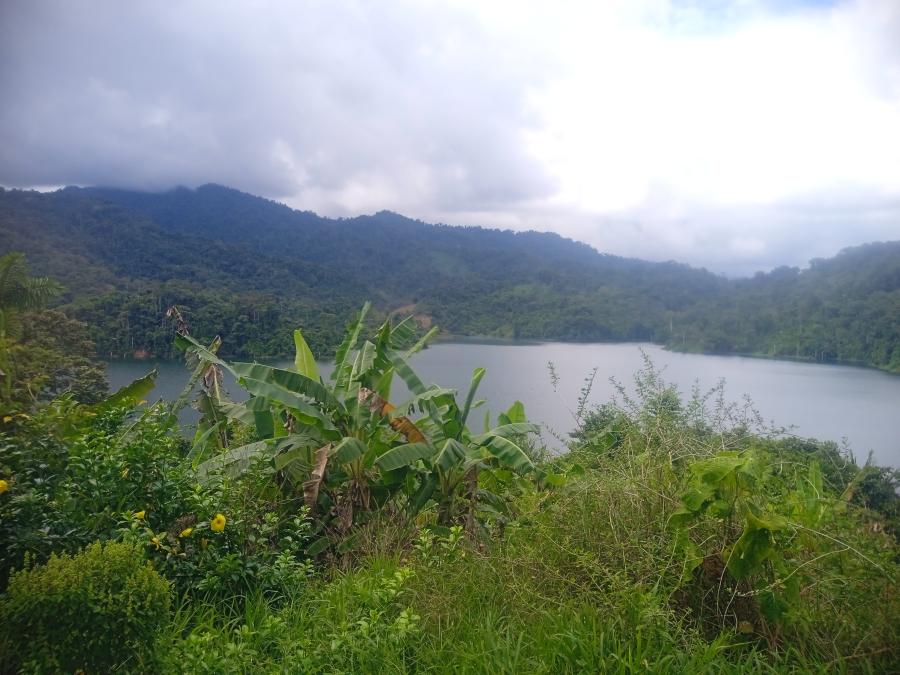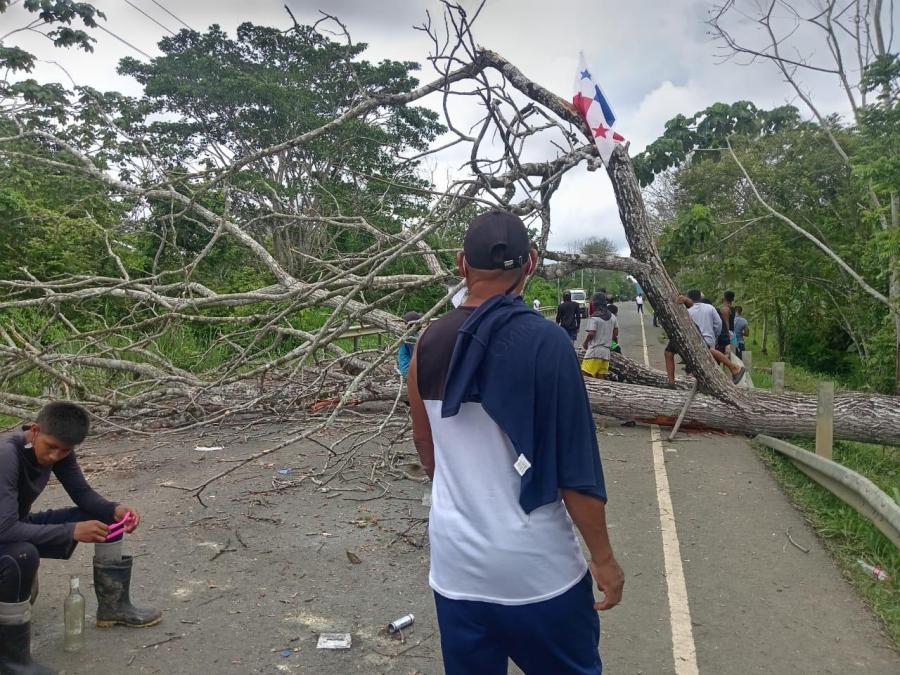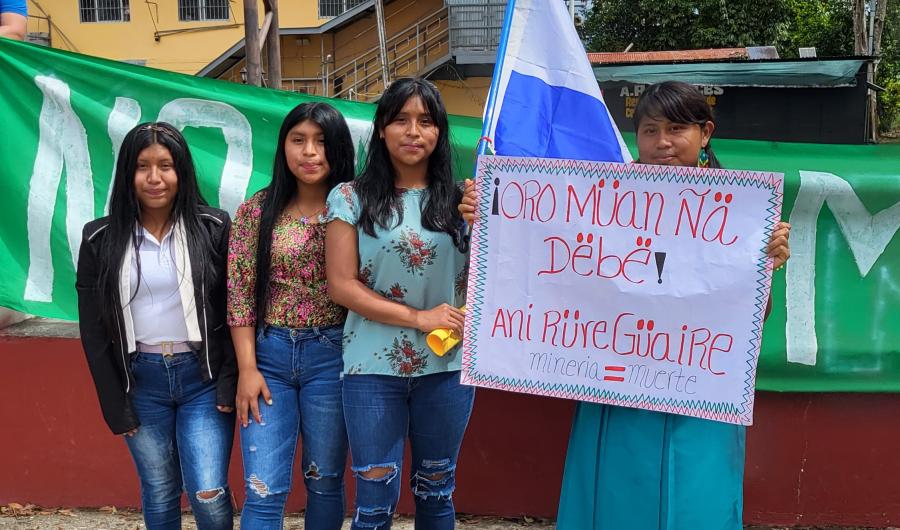The implementation of a health post infrastructure in rural Panama from 1972-1973 onward began to fulfill a long-felt need for adequate medical care among Ngawbere. The implications of government control have left Ngawbere cautious about who is "in charge" of their health care needs. First to receive help with the infrastructure were Ngawbere in Bocas del Toro Province, who have been more isolated than those in Chiriquí and Veraguas provinces.
Before the United Fruit Company entered the region in 1899, no doctor or clinic existed anywhere in western Panama. Merchants who sold pharmaceutical supplies were not regulated; many of them were located in Bocas del Toro or David, the only municipalities where imported medicines were sold on a regular basis north and south of the continental divide, respectively. Native to the region was an indigenous population whom outsiders called Guaymí, but who identified themselves as Ngawbere.
In the late 1800s the territory north of the continental divide was a frontier area that attracted a number of nationalities who settled along the coast (Nicaraguan, Colombian, Jamaican and other Caribbean). The newcomers primarily were fishermen, whereas Ngawbere were forest cultivators. At least one merchant had established a trading post among Ngawbere near Guoroni (Cricamola River) in the 1810s. By the late 1800s, at least two trading posts were located near the major concentrations of Ngawbere population along the Atlantic coast, namely Bluefields (Valiente Peninsula) and Canquintu (near Guoroni).
From the 1890s onward, the production of bananas increased along the Caribbean coast. When Colombia granted Panama independence in 1903, Ngawbere territory became part of two newly created provinces; Bocas del Toro (Atlantic coast) became the capital of a province of the same name and David (Pacific coast) became the capital of Chiriquí. Economic growth in Bocas del Toro through exports of bananas, lumber, turtles and coconuts was facilitated in the 1910s and 1920s by the arrival of several thousand Antillean laborers who had completed work on the Panama Canal. During this period, the population of both Chiriquí and Veraguas provinces remained relatively stable; the region experienced slight economic growth through the production of cattle, coffee and bananas. Whereas many of the newcomers to Bocas del Toro had perished form malaria, tuberculosis and yellow fever by the 1930s and 1940s, the Ngawbere population remained relatively stable; despite the influx of non indigenous settlers into Bocas del Toro and the burst of economic activity, Ngawbere remained the majority population north of the continental divide. South of the continental divide, they were numerous but not in the majority. For the first part, Ngawbere remained isolated in the mountains until the 1970s when growing numbers began to seek wage work on coffee, banana and sugar plantations.
Around the turn of the century, a few Ngawbere formed economic liaisons with the nonindigenous population in a manner that allowed schooling for their children. Schools in the provincial capital originally were attended by males only. When the schools opened their doors to young girls and, much later, to indigenous children, Ngawbere parents sent their children to live with non indigenous families while they attended school. The recollections of older Ngawbere indicate that nearly all of them who lived outside as children had at least one contact with a doctor or nurse. Upon the children's return to Ngawbere territory, however, indigenous medicine again became their principal source of health care.
Ngawbere territory north of the continental divide became an Indigenous Reserve by law in 1935; the reserve was extended to include Ngawbere territory south of the continental divide in Chiriquí and Veraguas provinces in the Decree of 1952/1954.
Access to Health Care
The 1950s was a decade for introductory primary schools into rural areas (including the outlying parts of the Indigenous Reserve), but government efforts for rural health care during President Remón's regime did not include areas in western Panama where Ngawbere lived. Only recently did Ngawbere gain access to the United Fruit Company Hospital as an occupational benefit, since they and the other indigenous populations in Panama were not hired by the banana plantations until the 1950s. When they were hired, Ngawbere became eligible for social security, which included the right to medical insurance, but only if they were living on the plantations; children and families were bereft of cosmopolitan health care, unless transported to the plantations, which, owing to travel distance and cost, was rare.
The paucity of cosmopolitan medical resources continued until 1973 when the government (through General Omar Torrijos) began introducing health posts into areas of difficult access throughout rural Panama. The strategy was to create an infrastructure that could provide local diagnosis, remedy and referral if necessary to a facility offering more advanced care, generally located in an urban center of the region. Nearly all of the health posts that were established in western Panama were placed along the outer perimeter of the Indigenous Reserve. A number of medicinal dispensaries also were constructed on the plantations.
Two programs exist through which Ngawbere can avail themselves of health post services: the occupational health program and the rural health program. Both programs provide primary (cosmopolitan) health care.
Ngawbere men working as wage laborers pay a compulsory premium as part of the government's occupational health program (about 1.5 percent per month, regardless of income level). The rights for medical attention through this program extend to the worker's immediate family, which includes the worker's parents, spouse and children under 16. The program does not cover the parents of the spouse. A worker who loses or leaves his employment loses his right to free services through the occupational health program. Instead, those persons who have no visible sources of income have a right to receive medical services through the ministry's public health program.
The rural health program was initiated in Bocas del Toro Province in 1973 as a part of the public health program. Under this national program, the ministry uses a sliding scale to determine the fee for its clients. The scale is based on average regional income rather than individual income; for Ngawbere, the fee is roughly equivalent to 25 cents for each consultation, not including the cost of medications, injections and other treatments.
Several Bocas del Toro communities have received help with installing a system of potable water conduits (aqueductos) in communities that already have health posts. These piping systems have not always proven successful, however, and often need repairs when cattle break the pipelines and require cleaning when dirt and debris clog the flow of gravity-pulled water. Low pressure when rains lag also creates barriers to potable water. Since a number of houses in some communities lack access to the tubing, their inhabitants resort to transporting water by hand from nearby springs. Sponsored by the Ministry of Health of Chiriquí, Veraguas and other rural provinces, programs such as vegetables gardens and fish preserves have not been implemented north of the continental divide owing to the year-round rainfall.
A few problems that cannot be treated at the health post require no more than a brief visit to the urban hospital, usually no more than few hours away by boat for coastal residents in Bocas del Toro or a similar delay by truck (if available) in Chiriquí and Veraguas provinces. For Ngawbere living in the mountains of Bocas del Toro, however, the travel distance is greater and more time consuming, since it requires travel on foot as well as by boat, which inhibits any kind of reasonable use of urban facilities when emergencies occur.
The coastal health assistants make arrangements for transportation to the hospital via boat. If a boat is available in the morning, people can return to their home by early evening. Otherwise people return the next day or remain for several days to receive additional treatment. The services provided in the urban medical centers are more extensive than those available through the health post, and include treatment for major physical trauma, as well as x-rays and laboratory tests. These urban hospital refer some clients to facilities elsewhere in Panama, where special medical units handle problems such as polio, tuberculosis and cancer.
Electric power is needed do refrigerate vaccines periodically delivered to the more isolated health posts. For this reason, a single designated health post in a given area receives a battery-powered generator. 6t least two communities within the Indigenous Reserve north of the continental divide have an electric power plant, which provides not only electric lights at night, but also the power to maintain refrigeration when supplies are brought in for a vaccination program. At such times, residents from outlying areas must come to a central health post to have their children inoculated.
Indigenous Practitioners of Medicine
Four types of indigenous practitioners provide medical care within Ngawbere territory:
- health assistant (cosmopolitan paramedical training)
- midwife (cosmopolitan paramedical training)
- herbalist (folk medicine)
- diviner (folk medicine)
The Health Assistant
Each health post within the Indigenous Reserve has a health assistant (ayundante de salud) who speaks the local language and resides in the community. The health assistants in Bocas del Toro Province identify with one of three classes trained since 1973; some 52 Ngawbere have graduated from these three classes. Requirements for enrollment in the training program include at least six to nine years of schooling and an ability to speak Spanish. Most Ngawbere health assistants work within the Indigenous Reserve; others hold positions in dispensaries on the banana plantations. In addition, the Ministry of Health has trained a number of Ngawbere women in aseptic birthing techniques; these women practice as local midwives (parteras).
The health assistant provides simple treatments for minor health problems and serves as the initial contact in the referral system between the community and the cosmopolitan medical centers where non-Ngawbere physicians, dentists and nurses are available. Health assistants are responsible for administering vaccinations, attending to various requests for medical assistance and organizing the community for such services as potable water. They open the health posts on an almost daily basis, and even make themselves available in the evenings and on weekends upon request. To aid in accidents and minor ailments at times when the health post is closed, the health assistant keeps various medications in his home for colds, diarrhea, vomiting, gastrointestinal problems anti-snake serum for some types of snakebite, antibiotics such as ampicillin for minor infections or infected insect bites, bandages, splints and a transport carrier for the injured. Each health assistant is trained to give injections and assumes responsibility for administering the program of vaccinations that is distributed throughout the country as required by law for younger persons, particularly the infant population.
The Traditional Healer
Two practitioners of indigenous medicine are mentioned in the chronicles: the herbalist and the diviner. Both continue as the primary sources of indigenous medicine today by providing folk remedies of various kinds. The diviner is more than just a medical specialist; he also serves as the primary authority for sanctioning rituals and often assumes other leadership responsibilities.
The practice of Ngawbere medicine centers on the use of materials from the forest. Whereas Ngawbere once used sticks, vines, water and stones to make medicine, the more common items today are sticks and vines that are prepared as botanical medicine. Nearly all Ngawbere medicines are taken internally, although a few medicines are used specifically for ritual message.
Coordinating Medical Services
After the introduction of health posts within Ngawbere territory, some changes occurred in the delivery of indigenous medicine. One basic change was in the storage of botanical medicine. Its method of preparation through cooking is relatively the same as it has been over the years, with the addition of steel pots for boiling, but the introduction of such items as liquor and soft drinks has made it possible to store the boiled medicine in a discarded bottle once it is rinsed clean. Anyone petitioning for medical assistance can be asked to return and bring an empty bottle to exchange for a bottle of prepared medicine. This exchange practice (1) gives the healer a readily accessible container in which to dispense prepared medicine and (2) permits larger quantities of botanical medicine to be cooked and stored overnight for pickup the next morning.
Another change wrought by the health post system is the growing acceptance of someone other than the traditional healer as a medical provider. Since many of the traditional healer as a medical provider. Since many of the traditional healers also support the introduction of health posts (at least in those areas with which I am familiar), people readily accept the health assistant as a practitioner who supplements the traditional healers. Physical trauma and acute gastrointestinal ailments commonly arrive before the health assistant whereas other kinds of problems are first brought to the traditional healer. Even healers bring their family members for services when they recognize their own inability to effect a cure. A number of health assistants also attend native rituals within the Indigenous Reserve. During field work, I heard that a traditional healer along the coast was the first to have his family inoculated when health posts initiated their services; I also have observed some assistants attending - and even petitioning to hold their own - native rituals.
Since the health assistant is indigenous, he readily refers clients to the healers for certain kinds of health problems; traditional healers likewise refer some clients to the health assistant. For example, a 1976 survey conducted by the Ministry of Health in Bocas del Toro found that of the 33 health assistants who were interviewed, 91.7 percent were involved in mutual referrals between themselves and the local healers (this was true not only for the indigenous but also the nonindigenous communities).
Despite the ease with which most of the health assistants and healers service their people (through an unspoken sense of teamwork), many practitioners are concerned over the kinds of medical services offered by the Ministry of Health. They recognize that certain problems are more prevalent and desire medications for these problems. But they often have to deal with the priorities of provincial politics wherein communities other than those in the Indigenous Reserve are the recipients of desired medicines.
A number of Ngawbere have recognized that priorities for medical services are not decided by the health assistants alone, although they do have some say in the needs of their communities. Desiring to maintain their self-sufficiency in health matters (as they have over the centuries), they are reticent about the formation of health committees as the proper vehicle through which medical decision making should occur. Instead, the more astute have facilitated the process of negotiating for better health care through their local representante who represents their interests before the provincial assembly. Ngawbere gradually are becoming more involved in the political process of the country, wherein the principal decisions are made that affect their lives and the quality of their health care.
Article copyright Cultural Survival, Inc.



